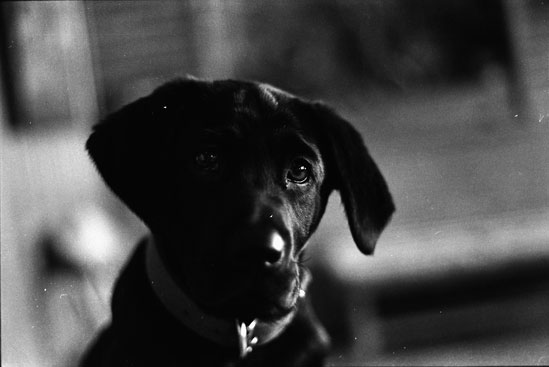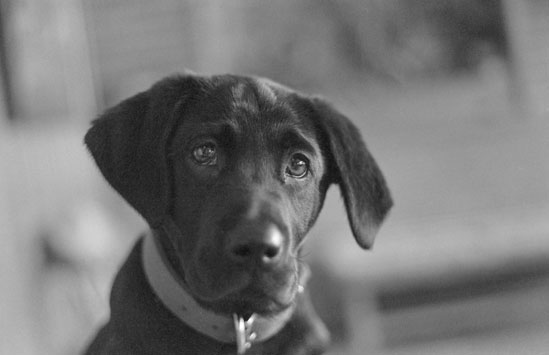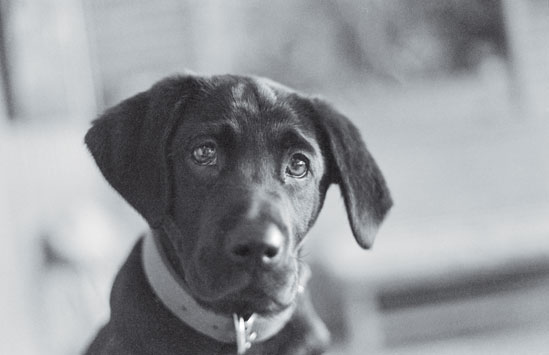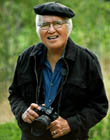|
|
This topic comprises 2 pages: 1 2
|
|
Author
|
Topic: Photo kiosks: Kodak vs. Fuji
|
Randy Stankey
Film God

Posts: 6539
From: Erie, Pennsylvania
Registered: Jun 99
|
 posted 12-21-2009 12:44 AM
posted 12-21-2009 12:44 AM




In two words: Fuji blows!
If you remember, I recently took on the job of rescuing a bunch of photographs from my brother's apartment which got burned to the ground.
http://www.film-tech.com/ubb/f8/t005983.html
I'm just finishing up that job. I restored a most of the pictures. Some of them were too badly damaged to restore. Luckily, I did get almost all of his "important" pictures.
(e.g. Pictures of grandparents, family and close friends.)
Unfortunately, there was one picture that was too far gone to save. That was a picture of his dog. It was very sad for him to lose that picture. I couldn't find the negative, either.
(Girls won't get it. There's just something that can't be explained about the bond between a boy and his "best dog." I tried to explain it to my wife. She just gave me a blank stare.)
I searched through my photo collection and I found a photo I took of "Reggie", the dog many years ago. I never thought it was very good so I never printed it. Ryan saw it. Now, he wants me to print that picture.
I decided that's going to be his Christmas present.
I don't have an enlarger. I haven't been in the darkroom in so long I wouldn't be able to make a good print before Christmas. My only option would be to go the digital route. Not a problem: I have a good scanner and a good computer. How hard could this be?
Not so fast!...
Here is a sample of the raw scan of the negative before I did any work on it:

Underexposed. Poor depth of field/focus. Needs spotting. And, worse, he's a black dog.
I was able to edit this image and get a viewable photo out of it:

I tweaked the exposure then spotted, sharpened degrained and otherwise fussed with it until I got it this far. Now, to print it and frame it and I'll be all done. My printer is going on 7 years old. It's still good for "everyday" work but for "nice" work, it leaves a lot to be desired. I figured the best solution would be to take it to Walmart and print it out on the picture machines.
I go to Walmart. There are two brands of picture machines there. Fuji and Kodak. I should have listened to my better judgment when I saw that there were 4 Fuji machine but only 2 Kodak machines. People were standing in line for the Kodaks and three of the Fujis were open.
I saw that the Fuji machines can make 11 X 14 prints but the Kodaks only make 8 X 10. I went for the Fuji. How different could they be? Right?
Well, I found out! The Fuji picture machines SUCK!
First, they only print out behind the counter. The Kodaks dispense prints on-demand. You have to wait an HOUR to pick up your print.
"What the hell?" I thought. I walked around and did a little last minute Christmas shopping. An hour later, I went back to pick up the print.
It turned out TERRIBLE!
First, the brightness and contrast that I worked so hard to restore were completely gone! It looked almost like the original scan. The whole left side of the dog's face was black. No detail at all.
Second, the color of the ink was jet black, not the smooth gray I got in the original picture. (Actually, it was a tri-tone.)
Third, there were tiny, little magenta and blue splotches all over the print. And, no, they weren't artifacts from the tri-tone. They were droplets of ink that the printer spit out.
I told the guy behind the counter that I wasn't going to accept the print and he couldn't understand why. I tried to explain why but he just didn't get it. I apologized and told him that this is a very important photograph to replace what was lost in a fire. I finally just said, "I'm sorry but I can't accept this." and walked out.
On my way out, I saw that one of the Kodak machines was unoccupied. I turned around and sat down. In about 7 minutes, I had two prints that were almost exactly as I expected. I paid for them and was out the door just a few minutes later.
Lesson learned! Avoid Fuji!
I should have listened to that little voice in my head to begin with!
My only beef with the Kodak machines is that the largest size they print is 8 x 10. I wish I could have had 11 x 14 or maybe 16 X 20, even.
| IP: Logged
|
|
|
|
|
|
Randy Stankey
Film God

Posts: 6539
From: Erie, Pennsylvania
Registered: Jun 99
|
 posted 12-21-2009 05:51 PM
posted 12-21-2009 05:51 PM




I can't say whether the printer was out of calibration or not but the print should not have come out jet black. The image was duotoned with the "CMYK-neutral" setting. So, technically, it was a color print.

The duotone was necessary to restore some gradation to the contrast that was missing in the B/W negative. Yes, I admit it was a bad negative. That's probably why I never printed it 25 years ago when I first shot it. You know how it goes, though. When my brother said that's the picture he wants, that's the picture I have to make. I think I did a pretty good job of pulling a good image out of a bad negative.
When printed the whole left side of the dog's face was black. There was no detail at all. The blurry background in the true image was reduced to a few black blotches. I can't imagine how the printer would have caused that. It seems like the color profile between the printer and the computer was screwed. Either that or there is some software routine that tries to average the brightness and contrast in the image to make up for exposure mistakes that common users make.
But, if that's the case, why did the Kodak machine produce an acceptable print the first time using default settings?
Secondarily, the image that I printed was 6000 pixels wide @ 600 dpi. The Fuji machine had trouble reading some of the files I had on my USB stick. The Kodak machine read all the files on the drive, including a few others.
I suppose I shouldn't paint all Fuji products with such a broad brush but it seems that my experience with Fuji is just the same as your experience with Kodak.
To me, Fuji film has always had a pukey, green cast to it. I have never seen that with Kodak.
I guess it's preference... ![[Shrug]](graemlins/shrug.gif)
| IP: Logged
|
|
|
|
|
|
Randy Stankey
Film God

Posts: 6539
From: Erie, Pennsylvania
Registered: Jun 99
|
 posted 12-21-2009 11:56 PM
posted 12-21-2009 11:56 PM




The white spots are in the negative from developing. They are probably dust on the film while it was in the camera or in the tank. I used canned air before scanning it. Prior to its use today, it was in a polypropylene sleeve. It only took me 30 minutes to spot them out with Photoshop. The same job would have taken all day if I did it with a brush. Damn! I love the "healing brush!" ![[Wink]](wink.gif)
Obviously, I'd be a lot more conscientious if I took the same photo today.
I like the high contrast of the original photo, myself. The problem is that this is a "memory picture" not so much an art project. If I was doing it for myself I'd probably go along the same lines as Mike.
If I really wanted to do it up right I would buy the photography teacher at Mercyhurst a couple of bottles of wine and weasel my way into the darkroom. Like I said, it's been so long since I've done real photo work that it would take me a week just to get my chops back. That doesn't include the time for me to tweak the print and get it "just right." I just don't have the time to do that. Taking it to the local photography shop and having somebody there do it would be prohibitively expensive for the level of this project.
Given the limitations I have to work under, the best solution was to scan the negative into my computer and Photoshop it at home then print it out at Walmart. Including the frame, I was able to finish this whole project for under $25.00. Since my brother was burned out of house and home, his "real" gift is going to be the envelope full of cash that's attached to the back of the picture frame. The photo is really just dressing.
When I went to the store, the main reason I went to the Fuji booth instead of the Kodak booth is because the Kodak didn't make prints larger than 8 X 10. I would rather have had 11 X 14. As I was standing there making up my mind, I thought, "Fuji and Kodak are both big kahunas in the photo business. How different can they be?" It was very disapointing to see how all my work turned out when I saw the results from the Fuji machine. Given that failure, I am willing to accept the smaller print when the quality is better.
When it comes to "wet" photography with real film, I'm sure Fuji is a fine product. Personally, I've only ever dabbled with it. Most of the time I used either Kodak or Ilford. As I said, the few times I have used real Fuji film I found it to have a greenish cast. That may have been due to some difference in technique that is necessary to get optimal results from Fuji. I don't know for sure. I've never really studied photography that much to really understand the differences.
At the end of the day, my lesson learned is to either go to the photography store and have my work done there (for a price) or not to use those Fuji self-service kiosks and stick with Kodak.
| IP: Logged
|
|
Bobby Henderson
"Ask me about Trajan."

Posts: 10973
From: Lawton, OK, USA
Registered: Apr 2001
|
 posted 12-22-2009 12:16 AM
posted 12-22-2009 12:16 AM




I simply cannot trust any sort of automated photo scanning or printing machine at Wal-Mart or any other store. Too many issues require abstract decision making through human intervention for the automated process to work in demanding circumstances like this.
Black and white photography can be especially demanding because you have to work really hard to preserve the blacks in the image. Otherwise it's weak-ass gray and white photography.
If I'm given a black and white image to scan, I'll scan it RGB and at 16-bit color depth per channel. The idea behind this is maximizing the histogram out for all it's worth. You have a full 48-bits of largely redundant image data that provides a lot more steps of gradation from light to dark. Or, in other words, it gives a lot more room to fudge the levels or curves to bring out certain areas of shadow or highlight detail without banding out midtones, clipping highlights or crushing the blacks.
If you only scan in 8-bit grayscale, you only have 256 levels of light to dark in which to work. If you do 16-bit grayscale it gives you 65000 steps. 48-bit double buffered RGB provides billions of steps. You just overkill the shit out of the scan and it will do much to keep banding, clipping and crush from screwing up the image. Still, you can only push the sliders only so far.
Even with a properly acquired and tweaked scan, a Wal-Mart printing setup can still goof up the results badly. It might be beyond the capability of most end users to download an ICC profile for the type of printer Kodak and Fuji is using. The end user could take such a printer profile and optimize the photo for that printer.
OTOH, Wal-Mart should have a variety of output profiles the customer could choose to get the best looking print. Obviously the output would need to be simulated on screen before the customer pressed the print button.
| IP: Logged
|
|
|
|
|
|
|
|
Bobby Henderson
"Ask me about Trajan."

Posts: 10973
From: Lawton, OK, USA
Registered: Apr 2001
|
 posted 12-22-2009 09:03 AM
posted 12-22-2009 09:03 AM




quote: Randy Stankey
Yes, I know taking it to Walmart was the "ghetto" way to do it but time and money were working against me.
Even still, those kiosk printers should be delivering at least decent looking results from images with standard color profiles attached. Chances are good the people running the printer don't have it set up properly.
The large format Roland printer in my office has dozens of different color profiles for different kinds of material, be it certain types of paper, Controltac vehicle wrap vinyls, window perf vinyl, painting canvas, etc. They may not have the right material profile selected for that printer (if it provides the choice).
You also have to be careful to choose the best CMYK color profile
as possible if you convert the image to CMYK. Most end users don't. They just run their RGB digital camera photo snap shots through the machine. Editing the image in CMYK will provide better, more predictable results but only if a proper color profile is used. Lots of printing service bureaus have their gear tweaked to use the default US Web Coated SWOP v2 profile Photoshop embeds into CMYK images. It's a question mark on whether that Fuji kiosk does. The best color profiles are ones created manually using colorimeter tools sold by outfits like X-Rite. But that's usually only useful when the scanner, computer and printer all reside under one roof.
| IP: Logged
|
|
|
|
Randy Stankey
Film God

Posts: 6539
From: Erie, Pennsylvania
Registered: Jun 99
|
 posted 12-22-2009 09:42 PM
posted 12-22-2009 09:42 PM




Never used AGFA. Only Kodak and Ilford. Dabbled with Fuji films.
In college, we used T-MAX film and Ilford RC papers.
Occasionally used Ilford chromogenic films.
When making prints, B/W were done by hand and color was done by machine.
I know the printers in the Kodak machines are dye-sub process. When I was standing in line, waiting for my (inferior) Fuji prints to be done, one of the attendants had to change the cartridge in one of the Kodaks. It had a ribbon cartridge in it. That's how dye-sub works. By heat transference. Right?
I'm betting this is the reason why Kodak machines only go up to 8 X 10. It's probably way too expensive to make a dye-sub printer any larger than that.
Anyway, this is probably why the Kodaks trounce the Fujis. Dye-sub has more continuous tone gradation. Right?
I think like you, Bobby. The more we use automatic equipment to do things for us, the more control we sacrifice and, ultimately, the more quality we sacrifice. There's no substitute for printing a picture the old fashioned way, by hand. If I had time and patience I would have done it this way. The result I got out of the Kodak machine was not as perfect as I would like it but it was quite acceptable. Given the fact that it was such a bad negative to start with, I'm happy with the result I got.
BTW: I gather by what you say that it would be wise for me to invest in an IT-8 target to build a profile for my scanner and printer. No?
| IP: Logged
|
|
|
|
|
|
All times are Central (GMT -6:00)
|
This topic comprises 2 pages: 1 2
|
Powered by Infopop Corporation
UBB.classicTM
6.3.1.2
The Film-Tech Forums are designed for various members related to the cinema industry to express their opinions, viewpoints and testimonials on various products, services and events based upon speculation, personal knowledge and factual information through use, therefore all views represented here allow no liability upon the publishers of this web site and the owners of said views assume no liability for any ill will resulting from these postings. The posts made here are for educational as well as entertainment purposes and as such anyone viewing this portion of the website must accept these views as statements of the author of that opinion
and agrees to release the authors from any and all liability.
|

 Home
Home
 Products
Products
 Store
Store
 Forum
Forum
 Warehouse
Warehouse
 Contact Us
Contact Us




 Printer-friendly view of this topic
Printer-friendly view of this topic









![[Shrug]](graemlins/shrug.gif)



![[Wink]](wink.gif)






